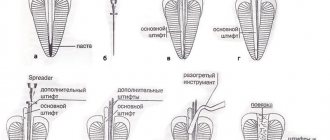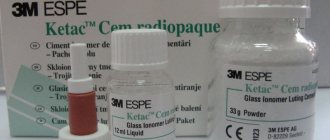Root canal filling – this method is used in dentistry in the treatment of dental diseases such as pulpitis or periodontitis. Before filling the canals, they are always subjected to antiseptic and mechanical instrumentation. The latter allows you to expand the lumen of the root canals and make their walls smoother - without which their high-quality filling is simply impossible. Filling of the canals is carried out using radiopaque materials so that the doctor can evaluate the quality of treatment using radiographs.
Most often, gutta-percha pins are used for this in combination with a special sealer (paste). Only a high-quality filling can prevent the subsequent proliferation of infection in the root canals, as well as at the apex of the tooth root. And well-filled root canals of teeth must meet a number of criteria, which we will discuss in this article. We will also talk about the main mistakes dentists make, each of which we will demonstrate to you on targeted X-rays.
Important: at the moment (according to official statistics) filling of root canals in the treatment of pulpitis and periodontitis in 60-70% of cases is performed poorly by dentists. This subsequently leads to the development of inflammatory complications and even tooth extraction - in the short and long term, respectively. Retreatment of such teeth is very expensive, because... associated with the need for their preliminary unsealing, after which they are re-sealed.
Dentists' mistakes when filling canals -
- Incorrect measurement of root canal length –
Root canals in a tooth must be filled strictly to the apex of the tooth root.
To do this, it is necessary to correctly determine the length of each root canal. Errors at this stage lead to the fact that the canals are either filled not to the apex of the root, or the filling material is carried beyond the apex of the root, directly into the bone. In the unfilled part of the canal, an infection develops, which leads to the formation of inflammatory foci at the apexes of the roots of the teeth, for example, apical granulomas or radicular cysts, which is accompanied by periodic suppuration and the appearance of pain when biting on this tooth. Refilling the canals can also lead to long-term pain, neuralgia, numbness of the lip and chin.
- Poor quality mechanical processing of the canals - such processing is necessary to widen the canals and give them a slightly conical shape. Only under this condition can they be sealed later. Numerous mistakes by the dentist at this stage (insufficient expansion of canals, formation of steps, root perforations) lead to subsequent poor-quality fillings and, again, to the development of inflammatory complications requiring new expensive retreatment.
Benefits of gutta percha
The peculiarity of gutta-percha is its composition. The product itself has a natural base, so it is absolutely safe for the body. The use of gutta-percha and zinc to make a pin is also considered an advantage of this filling method, since both materials have a high biocompatibility.
The advantages of filling dental canals with gutta-percha also include:
- complete sealing of the canals - due to the plasticity of the material, after heating it completely fills all cavities in the root canals, therefore eliminating the possibility of the filling falling out and the risk of infection getting inside;
- possibility of unsealing - in some cases it may be necessary to remove the pin; professional removal of all material will not cause difficulties for a specialist;
- interaction with medicinal substances - the filling material does not react with any drugs, as well as with the materials from which crowns are made;
- high strength - the gutta-percha pin does not deform, does not change color, does not oxidize and does not dissolve over time;
- visibility on x-rays - the base of the pin is made of zinc, so it is visible on x-rays;
Dentists prefer gutta-percha filling when treating canals, since this method is of higher quality, and during the filling process there are no difficulties with filling the canal voids or fixing the material.
Stages of root canal treatment –
High-quality filling of root canals in the treatment of pulpitis and periodontitis is the key to the absence of complications. But in order to fill the root canals, they must first be prepared for this. Since the root canals are very narrow, preparation for filling will consist of widening the canals and extending them along their entire length to the apex of the root.
Let's imagine that there is a deep carious cavity on the chewing surface of the tooth, and the tooth pulp is inflamed.
The main stages of root canal filling are:
- Removal of all tissues affected by caries (Fig. 2) - in this case, healthy tooth tissues can also be partially removed in order to create convenient access to the mouths of the root canals.
- Removal of dental pulp – pulp is removed from both the coronal part and the root canals.
- Determining the length of each root canal - each canal has its own length and depends on the length of the root and bends.
- Mechanical treatment of root canals (Fig. 3) - it is necessary to use special tools to go through the root canals the entire length to the apex of the root, and then expand the diameter of the canals to the desired size. If this is not done, it will not be possible to qualitatively seal the canal along its entire length (especially its far third at the apex of the root).
- Filling canals with gutta-percha (Fig. 4) is the final stage of working with root canals. The quality of this stage directly depends, first of all, on the correct measurement of the length of the root canals and on the quality of their mechanical processing.
After the filling procedure
Endodontic treatment is a common dental practice performed with a high success rate. Once teeth have been treated, in 85-95% of cases there is no need for re-treatment and refilling for 8-10 years, with proper cleaning and oral hygiene. Therefore, the cost of dental canal filling is completely justified.
The only drawback of such an intervention is the side effect - an incisor and molar devoid of pulp can change color and darken. In this case, the doctor recommends chemical bleaching.
The main stages on which the quality of root canal filling depends:
1) Determination of the working length of each root canal -
High-quality root canal treatment requires that the root canals be filled to the apex of the root. If the channel length is determined incorrectly, then there are 2 options :
- The root canal will be underfilled - this will lead to inflammatory complications, the development of periodontitis, cysts, and in the absence of retreatment of the tooth - to its removal.
- The root canal will be refilled - the filling material will be excessively removed beyond the apex of the root, and this can lead to long-term pain, neuralgia, and the development of inflammation.
Therefore, it is necessary to carefully measure the length of each canal in the tooth. This is done in good clinics as follows: after removing the pulp from the root canals, the doctor, using special thin hand instruments (for example, K-files - Fig. 7, 10) tries to go through each root canal to the apex.
The advancement of the instrument deep into the canal is carried out under the control of a special device “apex locator” (Fig. 6), which is connected with the help of an electrode to the K-file located in the canal (Fig. 7-8). The display of the apex locator reflects the depth of the instrument's immersion, as well as the moment the instrument tip reaches the root apex.
Important: the apex locator only shows an approximately accurate picture. Therefore, after measuring the length of the canal with an apex locator, the K-file is left in the root canal and the patient is sent for an x-ray. These K-files are radiopaque, so the X-ray can clearly see whether the tip of the instrument has reached the apex of the root.
2) Mechanical treatment of root canals –
The purpose of mechanical treatment is to expand the root canal and make it suitable for filling.
Untreated canals in most cases are very narrow, have many imperceptible narrowings and expansions, which will not allow the canal to be properly filled with filling material along its entire length. Thus, mechanical treatment should remove all narrowings and irregularities throughout the root canal, and expand it to a certain size.
There are 2 methods of mechanical treatment of root canals:
- Hand instruments (Fig. 10) - the doctor rotates such instruments in the root canal with his fingertips. Below you can see photos and videos of this method.
- Using an endodontic tip (Fig. 11) - special Pro-files made of nickel-titanium are inserted into such tips (Fig. 12). The endodontic tip rotates the profile in the root canal, as a result of which the sharp edges of the profile remove chips from the walls of the canal, expanding it. Due to the fact that the metal of the profiles has a shape memory effect, they do not break during rotation even in highly curved root canals.
The advantages of processing canals with such machine Pro-files over hand tools:
- The quality of canal treatment is many times higher - the surface of the root canal walls after such treatment is very smooth, as if polished, and this facilitates the insertion of gutta-percha pins for filling the canal. In addition, the use of an endodontic tip can significantly reduce the processing time of canals (compared to manual processing).
- Safety - in most cases, the endodontic handpiece comes complete with a smart micromotor (Fig. 11), which controls the movement of the file in the canal.
If a certain load is exceeded, which threatens to break the profile in the channel, the micromotor stops the rotation of the profile and turns on auto reverse. Therefore, the threat of the tool tip breaking off in this case is minimal, which cannot be said about manual files. After all, the doctor’s fingers, with which he rotates the “manual” file, feel quite weakly the extreme resistance to the movement of the instrument, after which the instrument breaks off in the canal. If your clinic performs mechanical treatment of canals using such smart devices, this is a big plus. However, it is worth remembering that in any case such treatment is performed by a doctor, and even the smartest and best device in the wrong hands can cause more harm than good (24stoma.ru).
Mechanical treatment of canals with hand instruments and endodontic handpiece: video
3) Filling root canals with gutta-percha –
After the root canals have been expanded and the root canals have been treated with medication, they need to be sealed. Root canal filling methods that can be used in dental clinics:
- One paste method - the canal lumen is filled with a plastic material, which then hardens. At the moment, there is no more terrible method of filling canals; complications develop in almost 99% of cases. If your doctor fills your canals in this way, then you need to run urgently! And if you can’t run, then you should at least crawl to the exit.
- Single pin method - after filling the root canal with paste (as in the previous version), one gutta-percha pin is inserted into the root canal. This method is slightly better than the first, however, the percentage of complications after such treatment is also close to 99%, and you also need to run.
- Method of lethal condensation of cold gutta-percha - the meaning of this method is to compact the pins of cold gutta-percha as tightly as possible along the entire length of each of the root canals. We will discuss this method in more detail below. The method has an affordable cost and high reliability.
- Vertical condensation of hot gutta-percha is the most effective method of filling canals, which is carried out using gutta-percha heated to a fluid state.
The latter then gradually cools and hardens. Due to the fact that at the beginning it is in a fluid state, gutta-percha flows even into the lateral microchannels, which cannot be sealed by any other method (even the lateral condensation method). There are many techniques for using this method and materials for it. However, the best system for filling canals with hot gutta-percha called Termafil. If you are willing to pay for quality and reliability, then this is your method. But be prepared for the fact that the cost of filling canals with Termafil will be high.
Video: filling canals with cold and hot gutta-percha
Indications for the procedure
If you regularly visit a specialist, most likely, your dentist during the examination will be able to identify and treat caries with medication, as long as it is on the surface and has not penetrated into healthy tissue and the root system and has not provoked its destruction. However, if you haven't been in the dentist's chair for a long time, you may need a root canal filling to restore the diseased tooth and maintain the health and integrity of your dentition.
Don't tolerate toothache, it can be a sign of infection!
The first signs that you need endodontic treatment are:
- Increased sensitivity or pain when eating hot or cold food or drinks;
- Pain when biting;
- Sharp pain when tapping on tooth enamel.
If you ignore these symptoms, you may find that they decrease or disappear over time. However, this does not happen because the infection went away on its own. This means that complications have arisen: the nerves in the pulp have died, and the inflammatory process caused by bacteria has ceased to cause pain. Eventually, signs appear that the infection has spread further:
- Swelling of the gums around the affected front incisor or chewing unit;
- swelling of the cheek;
- Temperature increase;
- Pus oozing from the gums;
- Discoloration of tooth enamel.
Seeking medical help from a dentist at the stage of toothache helps prevent the pathological process from moving into a more serious stage, and avoid complications such as periodontitis and tooth loss. Inflammation does not go away on its own, and the longer you delay visiting a doctor, the less likely it is that endodontic treatment will be successful and lead to the elimination of undesirable consequences.
Method of lethal condensation of cold gutta-percha -
In Russia, 95% of all root canals are filled using this method.
The method of lethal condensation consists in the doctor performing a number of stages, the success of which largely depends solely on the high-quality implementation of the previous stages. We are talking about the correct measurement of the length of the root canal, as well as the quality of the instrumentation performed. Lateral condensation of gutta-percha (scheme) –
- Selection of the main gutta-percha pin - the pin is selected depending on how much the root canal was expanded during mechanical treatment)
- Filling the root canal with sealer – sealer is a special paste that is used to fill the voids between gutta-percha pins. After introducing the sealer, the main pin is inserted into the canal (Fig. 14a)
- Compaction of a gutta-percha pin with a spreader - the compaction process consists of making reciprocating movements with the spreader instrument, with its help the gutta-percha is pushed towards the canal wall and space is freed up for the insertion of new gutta-percha pins. The spreader itself is shown in Fig. 14(b), and the compaction process in Fig. 14(c).
- Insertion of smaller pins and their compaction (Fig. 14 d, e, f) - up to 8-12 gutta-percha pins can be “compacted” in just one root canal. As a result, if we look at an enlarged section of the tooth root, we should see a picture like this - Fig. 17.
- X-ray control of filling - if everything is OK - we proceed to the next stage... But if we see that the canal is not filled to the top, or the pins extend beyond the root into the surrounding tissues - it is necessary to remove all the pins and start filling the canals from the beginning.
- Removing excess gutta-percha and sealer - after the canals are tightly obturated with gutta-percha and sealer, the tips of the gutta-percha pins protruding from the mouths of the root canals are cut off with a hot tool (Fig. 14 g, h). You can see what the mouths of the root canals look like before filling and after they have been cut, excess gutta-percha protruding above the mouths of the canals in Fig. 15 and 16, respectively.
- Temporary filling – After this, the tooth cavity is closed with a temporary filling. It is not allowed to fill the crown of a tooth in the same visit with filling the canals. Restoration of the tooth crown should be carried out at the next visit.
What is the cost of treatment?
How much does root canal treatment cost? The cost largely depends on the method used and the quality of the materials. When using laser and microscopic technology, nanocomposites and other advanced developments, the cost of tooth treatment with canal filling increases significantly. Approximate prices for root canal treatment in Moscow with gutta-percha filling and composite filling are presented in the table below.
| View | Price |
| Single channel tooth | 9,500 – 12,5000 rubles |
| Double channel tooth | 11,000 – 14,500 rubles |
| Three-channel tooth | 13,500 – 17,000 rubles |
The cost of root canal treatment should not be the determining factor in choosing a clinic. Contact only dentistry with a good reputation and experienced specialists who use modern equipment and the latest techniques in their work. Remember - the future fate of your teeth and the aesthetics of your smile depend on the quality of canal treatment!
Recommendations after treatment
Endodontic treatment demonstrates high success rates. After the intervention, you must adhere to the following recommendations:
- Avoid too hot, spicy, or cold foods for several days (while teeth sensitivity remains).
- Maintain good hygiene – brush your teeth twice a day, use dental floss and an irrigator.
- Do not chew anything hard (do not chew nuts, candies, etc.), as this may result in damage to the root canals and tooth destruction.
- Undergo medical examinations with a dentist and hygienist (at least 2 times a year).
Immediately after the procedure, tooth sensitivity increases greatly. This is explained by the reaction of the tissues to the filling material. The discomfort will disappear in a few days.
Additions to temporary fillings
Dental experts have different opinions about how calcium hydroxide should be used. Some say that it is enough to use the product only once. Others believe that replacement is required at intervals of 1-3 weeks. Still others believe that replacement should be carried out as needed.
In addition, many studies have shown that in combination with other drugs, a temporary filling will be even more effective. For example, iodoform helps the composition penetrate into the dental root canals to a depth of 300 microns. Paramonochlorophenol and glycerin help destroy bacteria in the canals within a day, which cannot be achieved with ordinary hydroxide.
2% chlorhexidine gel in the paste makes it possible to increase the antimicrobial activity of the filling. The dentist selects the composition independently; in each individual case, this option will be individual. Many companies that manufacture compositions for temporary fillings state that it is necessary to wear a temporary filling for at least two weeks. But such a period makes treatment problematic, since patients often forget or do not want to come for a second visit.










